Passenger Stations of Tōkyō
Train stations in Tōkyō run from simple one-track affairs, through massive complexes like Tōkyō Station (31 platform tracks, including above and below ground stations, serving subway, normal and Shinkansen trains). Most common perhaps are two track stations, but even those can be complicated with additional platform tracks for passing use. Tracks for train storage or maintenance vehicles are sometimes associated with stations, as well. And stations may have through tracks for freight or express lines that do not have platforms.
Larger stations may serve multiple lines from more than one company. Many stations also serve as links to other transit systems, both rail (e.g., subway, monorail, and light-rail “tram” systems) and road (bus, taxi, and fixed-guideway wheeled vehicles).
This page provides some details on a few of the more interesting stations in Tōkyō. It’s hardly complete (there are dozens, if not hundreds of stations in the city’s wards). But it should provide a flavor for what passenger stations there are like.
Kinshichō Station, JR East Sōbu Line, Sumida, Tōkyō
Kinshichō Station in Sumida Ward would be a simple four-track (Rapid and local) station, except for the addition of both maintenance vehicle tracks and storage tracks. What makes this especially interesting is that all of these tracks are elevated above the surrounding city, with a major avenue (Yotsume Dori) passing directly under the platform and storage tracks. Keiyo road (route 14) runs in front of the station.
Kinshichō Station was, in part, the inspiration for my Urban Station scene, although only in the most general sense (my station isn’t intended to be a representation of it).

As with most larger JR stations, there is a large bus/taxi plaza in front of the station, and a subway station below it. In the picture below, the tracks run behind the “Termina” building, extending both right and left and the plaza shown is adjacent to route 14. There is another bus/taxi plaza on the north side as well.
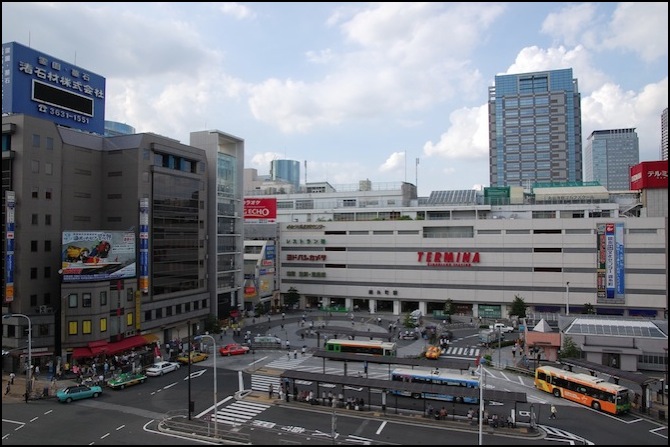
Kinshichō Station south exit and bus plaza (2008)
Photographer: oisa
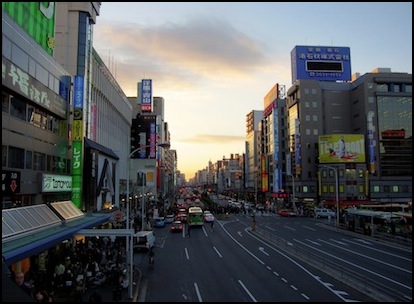
Route 14 in front of Kinshichō Station’s south exit (2010)
Photographer: ototadana
The storage tracks appear to be used for E217 Sōbu-Yokosuka trainsets.
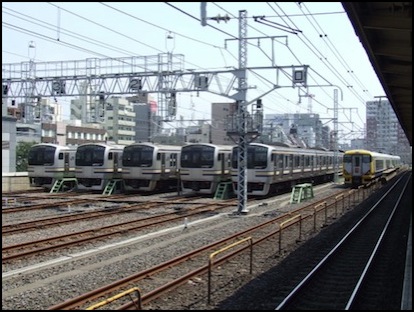
JR East Trains at Kinshicho Station (2007)
Photographer: Lover of Romance
Ochanomizu Station, Chiyoda, Tōkyō
Ochanomizu station lies alongside the Kanda river, where the Chūō Main Line (used here by Chūō Rapid trains) and Chūō-Sōbu Lines come together, one stop west of Akihabara on the Chūō-Sōbu Line and two stops west of Tōkyō Station on the Chūō Main Line. The Marunouchi Subway line passes below the station, crossing the river in the open, and has an associated station nearby.
The station itself is quite long, and the outer tracks of the Chūō Main Line descend relative to the center tracks of the Chūō-Sōbu Lines, ducking under them and turning south just east of the station, while the Chūō-Sōbu Line climbs and curves slightly north over the river before entering Akihabara station on a platform above its north-south lines.
Ochanomizu station and the associated subway were the inspiration for my Riverside Station scene, and although that differs substantially in detail I think the similarities will be obvious.
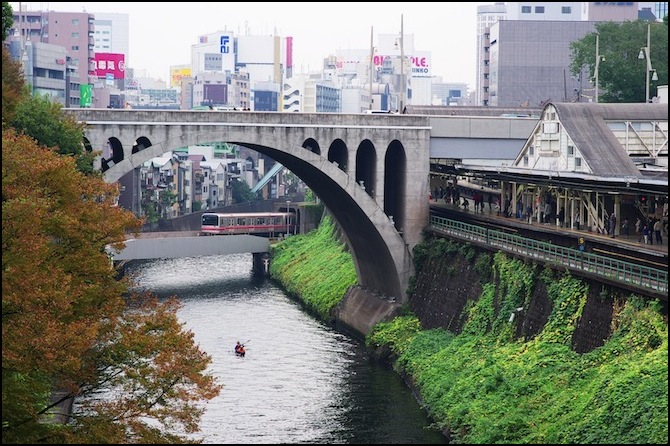
Ochanomizu station (center) and the Kanda River, with Marunouchi Line train crossing (2011)
Photographer: ototadana
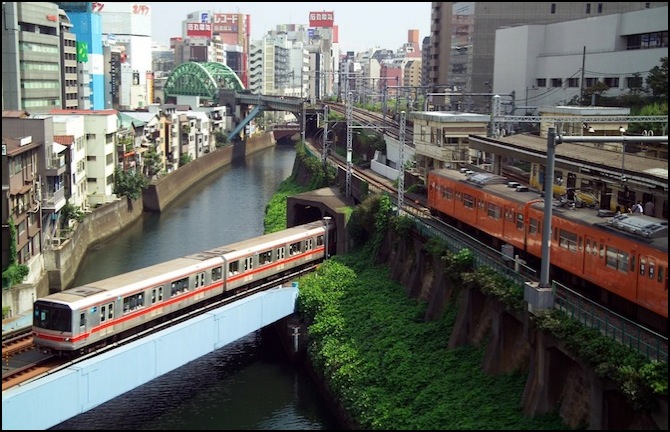
Marunouchi (left) and Chūō Rapid (right) trains, looking towards Akihabara
Photographer: Frank "Fg2" Gualtieri
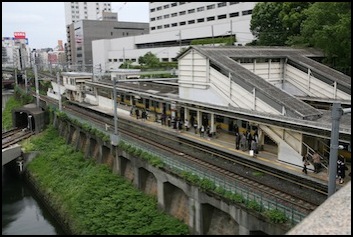
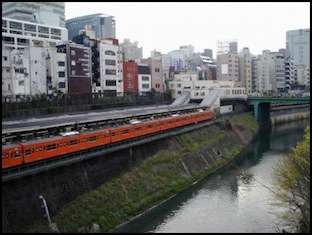
Ochanomizu station East end (2008) and West end (unknown date) from the arched bridge
Photographers: s.yume and Ianb
Keisei-Kanamachi Station, Keisei Railroad, Katsushika, Tōkyō
In contrast, Keisei-Kanamachi Station, in Katsushika Ward, is about as basic as a station can get: a single dead-end track, and one side platform. This line of the Keisei railroad has three stations, Keisei Kanamachi, Shibamata, and Keisei-Takasago, and is basically a north-south connecting line (entirely within the ward) from the Keisei main line at the southern end to this station at the northern end, adjacent to JR’s Jōban line Kanamachi station. The line is single-tracked north of Shibamata, or about two-thirds of its length.
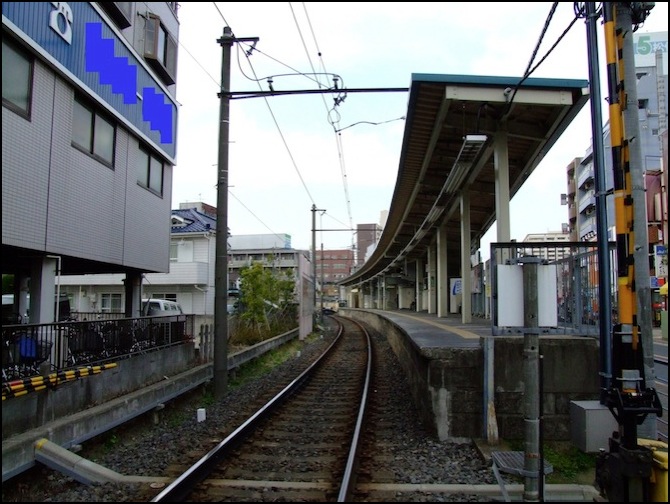
Keisei-Kanamachi Station platform (2006)
Photographer: LERK
Ōgimachi Station, Kanagawa, Tōkyō
Another single-track station is JR’s Ōgimachi Station, in Kanagawa, on the Tsurumi branch line off the Keihin-Tōhoku line (just 22 km south of Tōkyō Station, but in Kanagawa prefecture). Although this is also a short branch line, this one serves an industrial, rather than residential, area, and behind the station (to the left in the photo below) is a small yard for tank cars. The line itself is double-tracked (with stations on different sides), but all of the stations appear to be single-track side platforms.
The platform appears to be sized for a four-car set, although Google Earth presently shows a 3-car set at the platform, and wikipedia says that three-car sets of 205-1100 series cars are used.
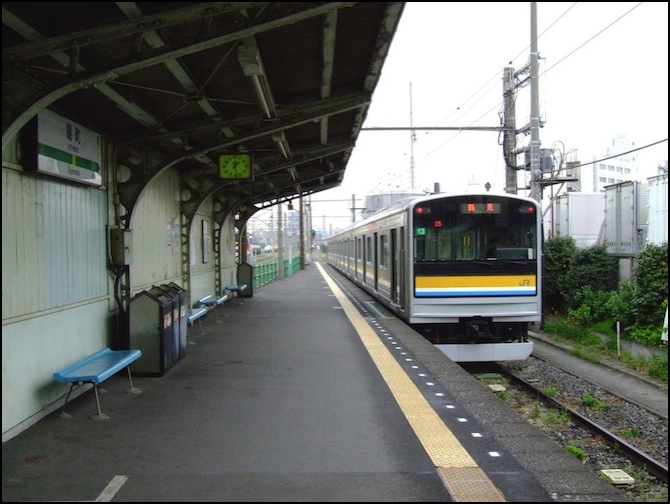
Ōgimachi Station platform, with 205-1100 series train (2006)
Photographer: LERK
Togoshi-kōen Station Station, Shinagawa, Tōkyō
While most platforms of Tōkyō-area stations are quite long, sometimes even with provision for two trains, there are exceptions. One of these is the Tōkyū Ōimachi Line’s Togoshi-kōen Station, which serves 5-car “local” trains at 3-car double-track platforms. Two end cars are not used at this station, although there is a small platform allowing the conductor to step out at the front, to view the rear of the train when running towards Ōimachi. The station is at grade, and sandwiched between two grade crossings, in a dense residential neighborhood, which likely prevented the expansion of the platform as train sizes grew.
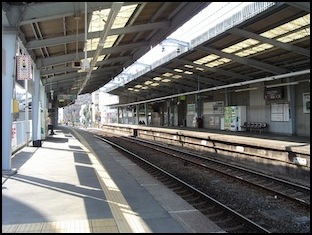
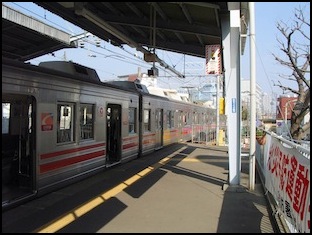
Togoshi-kōen Station platform
Photographer: 東京特許許可局 (Tokyo Bureau of Patent Grant)
Ōtsuka Station, Yamanote Line, Toshima, Tōkyō
Ōtsuka Station on the Yamanote line (the major loop line around central Tōkyō) has an interesting feature: it’s an elevated station with a ground-level “tram” (Trolley) station for the Toden Arakawa line below it. The station is a simple island-platform station for the two tracks of the Yamanote line, with the parallel two tracks of the Yamanote Freight Line (used by the Saikyō and Shōnan-Shinjuku lines) passing through it.
The Toden Arakawa line is particularly interesting, as it’s one of only two remaining streetcar lines in Tōkyō (the other is the Tōkyū Setagaya Line). Both streetcar lines use 1,372mm track gauge (4’ 6”), rather than the 1,067mm (3’ 6”) gauge used by most urban trains.
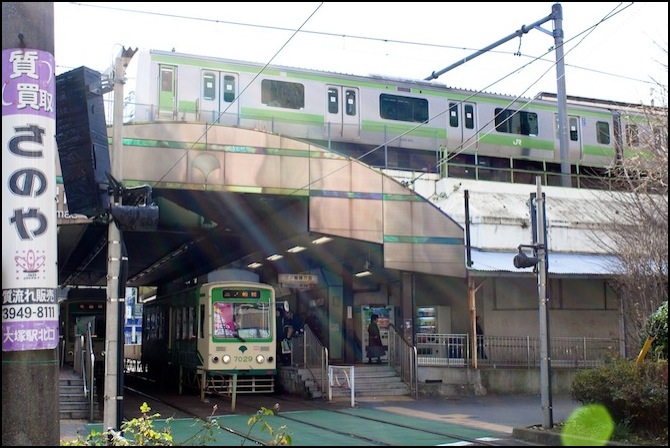
Ōtsuka Station, with Yamanote and Toden Arakawa trains
Photographer: Mullenkedheim
Details
While it’s not in Tōkyō, the picture of Nagoya Station below shows how platform roofs don’t have to be a continuous structure of the same form. Anyone who’s ever wanted to mix two different kinds of Kato platform segments in one station has a clear precedent here.
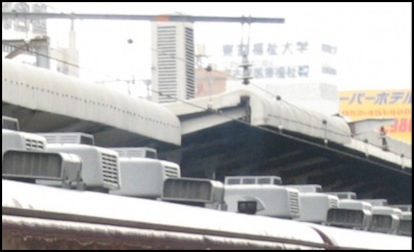
Platform Roofline Mismatch, Nagoya Station (2006)
Photographer: Tsuginotsuke (継之助)




